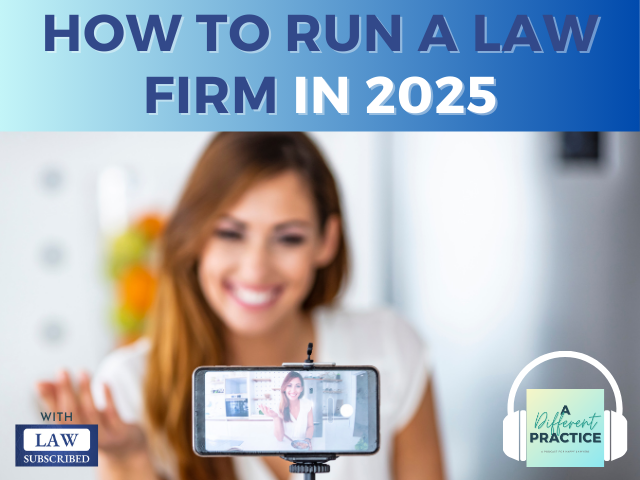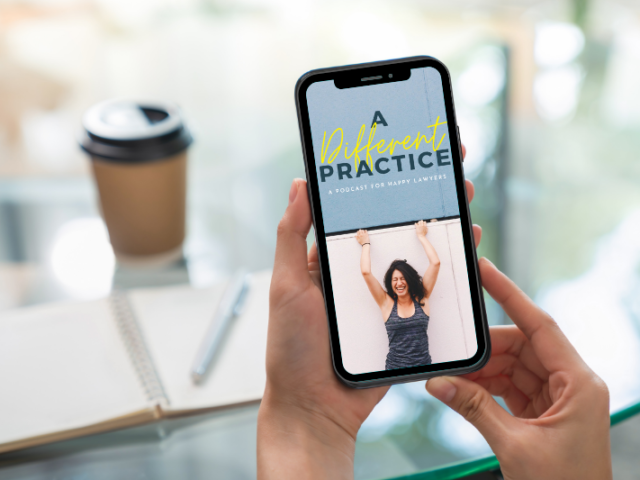Episode Description
Ever received that dreaded “We need to talk” email from a client? In this candid episode, I share how a single phone call transformed my relationship with a furious client and taught me an invaluable lesson about connection over correction.
Whether you’re a solo attorney struggling with client communication or looking to prevent problems before they start, these five actionable strategies will help you navigate difficult client situations with both empathy and strategy.
Learn why responding within 24 hours is non-negotiable, when to pick up the phone instead of hiding behind email, and how to resist the urge to be “right” when clients are upset. This episode isn’t about being perfect—it’s about building deeper trust through honest, human connection. Plus, discover when it’s time to refund and walk away from client relationships that simply aren’t working.
Stop dreading client conflicts and start using them as opportunities to strengthen your practice.
Listen Now!
Episode Transcript
LAUREN: [00:00:00] Just because you’re right doesn’t mean you’re right. Sometimes you’re right and you’re still losing the argument. Welcome to a different practice. I’m your host Lauren Lester, and I’m passionate about helping solo attorneys build thriving practices. After starting my own solo firm, straight out of law school and building it to a successful practice that earns well over six figures while working part-time, I’m here to share the tools and strategies that made it possible.
Think of this as grabbing coffee with your work bestie while learning everything they didn’t teach you about running a business in law school. Pull up a seat and get ready to build a different practice. This story still makes me cringe a little bit when I think about it, but I wanna share it with you.
A few years ago, I was representing a client in a divorce case. The client was the victim of domestic abuse. It was high stakes, emotionally charged the whole nine yards, and I thought I was doing everything right. I was working the case hard. I was crossing all [00:01:00] my T’s, dotting all my i’s, and then I got the email, you know the one, it scrolls for miles thinly veiled accusations of incompetence and the unmistakable undercurrent of I’m about to fire you.
My client was furious about something I hadn’t done, or at least something she thought I hadn’t done. My first reaction defensive. I pulled up my receipts, my time logs, my email exchange. I was basically building my case against my own client. I was right. She was wrong. End of story. But then I had this moment of clarity while I was fuming.
What if two things could be true at once? What if I had done everything technically correct, but she still felt unheard or unsupported. What if this wasn’t about being right, but about connecting? So I did something that felt terrifying in the moment I picked up the phone. I know. Funny, right? Not email, not text, but the actual phone.
And [00:02:00] instead of leading with, actually, here’s why you’re wrong, and here’s all the reasons why. I started with, I hear how frustrated you are and I wanna understand more, and that conversation completely turned our relationship around and it taught me something really crucial that I use every single day in my practice now.
So here’s my question for you to start this episode. What do you do when a client feels unheard, unhappy, or even downright furious with you? Because let’s be honest, it happens to all of us no matter how good we are. This episode isn’t about being perfect. It’s about being human, making real connections, and handling those tough moments with both empathy and strategy.
Welcome to a different practice. I’m so glad you’re here with me today. Here’s the thing, unhappy clients happen. They just do. It’s part of the job. But how you handle those moments can either salvage the relationship or burn it to the ground. And for those of us running solo [00:03:00] practices, every client relationship matters.
Every review, every referral, every interaction, and I’ve been thinking a lot about this concept from Will Giardi ass book on Unreasonable Ho. Vitality. The idea that sometimes going above and beyond isn’t just nice. It’s necessary. And what I love about his approach is that it’s proactive, not reactive.
The best way to handle unhappy clients is to prevent them from becoming unhappy in the first place. But since we don’t live in a perfect world today, we’re gonna dive into five practical, actionable strategies for turning difficult client relationships around. I’m talking real scripts, real tactics, real results.
No fluffy. Just be nice advice that leaves you wondering what to actually say when your inbox pings. With that dreaded, we need to talk message. So what’s the single biggest mistake I have seen attorneys make when a client is unhappy? Radio silence. Look, I get it. When someone is upset with you, the natural instinct is to avoid them.[00:04:00]
Maybe you need some time to collect your thoughts or check some facts before responding. Maybe you’re just busy with other cases. Maybe you’re hoping the problem will just magically resolve itself. Spoiler alert, it won’t. Here’s the truth. Every hour that passes without a response, your client’s frustration is compounding.
Their narrative about you is solidifying. My lawyer doesn’t care. They’re ignoring me. They’re hiding something. So you have to respond within 24 hours, period. And I don’t mean a full solution, I mean even just a quick acknowledgement that says, I got your message. I hear your concerns. I’m looking into it.
Here’s a simple script that you can adapt. Hi John. I received your message and I hear your concerns. I’m reviewing everything and we’ll reach out shortly to discuss it in more detail. I appreciate your bringing this to my attention. That’s it. 30 seconds to write it, but it communicates three crucial things.
One, I see you two, I take this very [00:05:00] seriously, and three, I’m actively working on it. Even if you don’t have a full answer yet, just being seen and heard matters enormously to the clients who are feeling frustrated or overlooked. Remember, most client complaints aren’t actually about the legal work itself.
They’re most often about feeling neglected, and let’s be real, even if you don’t have the answer yet, it is far better to say I’m on it than have them assume that you’re ghosting them. No one likes to be ghosted, especially by someone they’re paying thousands of dollars to. It’s like dating the most expensive person in the world who doesn’t text you back.
Not a good look. After you send a response, acknowledging their concern and making them feel seen within 24 hours, the next step is to pick up the phone. Look, I love email as much as the next person. It creates a record. It gives me time to think. It lets me craft the perfect response. But when a client is unhappy, email is the worst possible medium.
Why? [00:06:00] Because email strips away tone, nuance, and humanity. It’s like trying to diffuse a bomb while wearing oven mitts. You just don’t have the dexterity that you need. And this goes back to my story from the beginning of the episode when I finally picked up the phone and called my upset client.
Everything changed. I could hear her emotion in her voice and she could hear the genuine concern. In mine, we connected as two humans, not just as lawyer and client. So here’s how I start these calls. I wanted to personally check in with you. I understand you’re feeling frustrated, concerned, disappointed, whatever, and I wanna understand more.
Then comes the most important part. Shut up. And listen. Don’t interrupt them. Don’t get defensive. Just listen completely, even if what they’re saying isn’t entirely accurate. Lead with empathy, not with defense. Validate their experience first because to them it is real and it deserves validation. And then offer your [00:07:00] perspective.
And honestly, because nothing says I’m avoiding you, like a two sentence email with perfect grammar and a formal signature. When you say something like, thank you for your concerns, they have been noted. You might as well just say, I’m terrified of this conversation and I’m hiding behind my keyboard. That all being said, after you have the call, it is still smart to follow up with a brief email summarizing what you discussed, something like, as we talked about on our call, I’d be happy to, whatever specific action you’re gonna take by whatever specific date you’ve determined, this gives you the record that you need while still maintaining that human connection.
Alright, third tip. Don’t get defensive even when you’re right. This one is the hardest. For me personally, I had to learn this the hard way because as an Enneagram one, being right just makes me feel secure. I love having the facts on my side. I love making airtight arguments, so when a client is upset about something and I know I absolutely know that they are mistaken.
My first [00:08:00] instinct is to. Prove it. Actually, if you look at my email from March 15th, you’ll see that I did, in fact tell you exactly that this would happen. Has that approach ever worked? Not once. And not a single time in the history of client relationships has responding like that ever made the situation better.
And the client go, you know what? You’re right. Because here’s what I learned in that moment. They don’t care if technically you’re right, they care about how they feel and telling somebody that they shouldn’t feel the way that they feel is basically relationship suicide. So instead, try an approach like this.
I hear you and you’re right about. Find something that they’re right about, even if it’s just the right to be concerned. So you would say, and you’re right about being concerned, here’s my perspective as well. This is what I meant before about two things being true at once. They can be right, that they feel neglected and you can be right, that you’ve been communicating regularly.[00:09:00]
They can be right that the case is taking far longer than they anticipated, and you can be right that you’re moving it along as fast as you can. When you acknowledge the validity of their feelings first, the client is far more likely to be receptive to your perspective, and from that place, you can work together to find a solution.
If your client is feeling neglected, you can ask them, well, what can I do to help? Or What would help you feel more informed about your case? Maybe all they want is a simple check-in or access to their case file. Oftentimes what would help is easily doable. Of course, if you have a client who demands daily, hourly phone calls, that probably is not gonna work.
So in that case, you can offer suggestions for solutions from your perspective that will meet them in the middle. It has to work for both of you. But letting the client take the lead can often assuage their concerns or frustrations. And remember, and I’m saying this to myself too, just because you’re right doesn’t mean you’re right [00:10:00] sometimes you’re right and you’re still losing the argument when we’re talking about client relationships.
Choose connection over correction
practice. Number four, set expectations early and often. Alright, let’s talk about preventing upset clients now, because most client dissatisfaction comes from one thing, missed matched expectations, they expect weekly updates. You thought monthly was fine. They expect a quick resolution. You knew this case was gonna take a year.
They expected you to handle something that wasn’t a part of your engagement. You knew that. You defined that in the scope. Clear, consistent expectation setting is the single most powerful tool you have for preventing unhappy clients in the first place, period. Let me say that again for the folks in the back.
Consistent, clear expectation setting is the single most powerful tool [00:11:00] you have for preventing unhappy clients in the first place. From the jump, you’ve gotta be crystal clear about possible outcomes, including worst case scenarios. You’ve gotta be clear about realistic timelines, and then add a buffer.
You have to be clear about what you can and cannot control, and how if there are other parties involved, including the court that can influence the direction of the case and potentially add additional work that’s required. You’ve gotta be clear about how and when you will communicate with them and what they need to do and by when.
Here’s a script that I use at the beginning of every new client relationship. Here’s what I can promise and here’s what I can’t control. I will always keep you informed, but I also wanna be honest about the challenges that we might face, and then this is the key. I over communicate rather than under communicate.
I send status updates even when there’s nothing new to say. People would rather hear, well, we’re still [00:12:00] waiting than hear nothing and assume you’ve been abducted by aliens, or more likely that you’ve forgotten about them entirely. One trick I’ve started using is scheduling a weekly task reminder to check in with clients.
Even when there’s no update, I say something like, just wanted to let you know I’m still working on X, or We’re still waiting on Y, and I expect to hear something by z. It takes two minutes to write, but it completely transforms the client experience. And if you haven’t listened to episode 33 about how I use text expander to send updates like this in seconds instead of minutes, go back and check that episode out.
Will Giardia talks about this in his hospitality philosophy? He says to think about the experience you want your client to have, and set the tone early. Be proactive, not reactive. Anticipate their questions and concerns instead of waiting for them to bubble up into full blown problems. Strategy number five.
Know when to refund or walk away. Sometimes despite your best efforts, a client relationship just [00:13:00] isn’t working, and that’s okay. In fact, recognizing that early can save everybody time, money, and emotional energy. My simple rule is if the service wasn’t delivered as promised, I refund without question.
Integrity matters more than the fee. But what if the work was delivered and it was done well, and the client’s still unhappy? Well, this is trickier, but here’s my approach. I consider whether the relationship is worth salvaging both for me and for the client. Some client attorney relationships just aren’t a good fit.
Maybe your communication styles clash. Maybe their expectations will never align with reality. No matter how clearly you explain things, maybe they need a different type of personality or an approach that you just don’t provide. In those cases, it’s okay to say. I understand this hasn’t been the experience you hope for.
If you’d prefer to work with another attorney, I completely understand and will help make that transition smooth. My goal is to make sure you get the type of service you’re looking for. [00:14:00] If you need to refund the fee and move on, that lost revenue will be far less than the damage that could be caused by the client telling everyone in town or worse, everyone online about their one-sided experience that isn’t reflective of how you do business.
Parting ways with a client or having to issue a refund even when the work you did was great. It’s just good business. An unhappy client who stays is far worse for your practice than an amicable parting of ways that respects everyone’s time and feelings. Sometimes breaking up is the best option. It’s like dating.
Not every relationship is meant to last, and that’s not only, okay, it’s actually healthy. It frees up space for clients who are a better fit for your practice, your personality, and your way of working. Alright, now that we’ve covered five practical ways to address an unhappy client, here is my challenge to you this week.
Take a hard look at your client communication practices. Where could you be more proactive? [00:15:00] Where could you set clear expectations? How quickly do you respond? When problems arise, pick just one of these five strategies to implement this week. Commit to responding to all client concerns within 24 hours.
Switch from email to phone for difficult conversations. Practice validation before explanation. When clients are upset, create a script with clear expectation setting for new clients. Or identify any current client relationships that might need to end. Remember, handling an unhappy client isn’t just damage control.
It’s an opportunity to build deeper trust. Some of my strongest client relationships today started with a moment of friction that we worked through together that made our relationship stronger because the client could see that how they felt was important to me. I validated that and we found a solution that worked for both of us.
I’d love to hear how these strategies or others work for you when dealing with an unhappy client. Share your [00:16:00] experiences on LinkedIn and tag me or shoot me an email with your success stories or questions you might have. And if you found this or any other episode helpful, it would mean the world to me that you subscribe to the podcast and leave a review.
It helps the podcast and me out tremendously, but more importantly, it helps other attorneys find these conversations so that they can build practices they love too. Remember, it’s not about building a perfect practice. It’s about building a human practice. You’ve got this. Until next time, keep building a different practice.
Thanks for joining me on another episode of a different practice. If you found value in today’s conversation, subscribe to my Solo Success Lab newsletter, where each week I test and share what actually works in solo practice. Sign up for free@adifferentpractice.com slash subscribe. Wanna help other lawyers transform their practices too?
Follow the show. Leave a rating and share this episode with someone who might benefit. And if you’re ready to take your practice to the next level, [00:17:00] download my free guide to the six pillars of optimization@adifferentpractice.com slash optimize. I’ve distilled nearly a decade of experience, including all the mistakes and victories into the essential elements every successful law firm needs.
I’ll see you next time, and until then, keep building a different practice.





